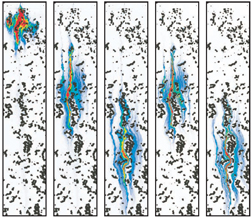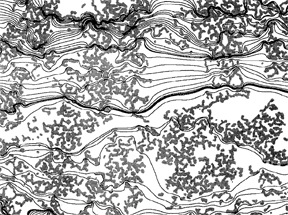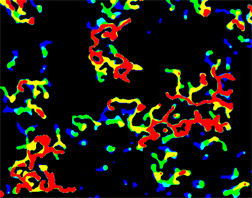Modeling Flow and Concentration

Solute transport experiments performed in an engineered glass fracture are modeled using particle tracking though a three dimensional velocity field. The velocity field was generated using the measured fracture aperture and entrapped air geometry. The first three images are experimental data and the last two are model realizations.
Detwiler, R., H. Rajaram, and R.J. Glass, Solute transport in a partially-saturated variable-aperture fracture, Geophysical Research Letters, 29/8/10.1029/2001GL013508, 2002.
Characterizing Relative Permeability

Stream lines are here associated with an example fracture-air phase structure. The flowing phase is shown as white and the entrapped air phase in gray. Advective particle tracking was used to map the stream lines.
Nicholl, M.J., H. Rajaram, and R.J. Glass, Factors controlling satiated relative permeability in a partially-saturated horizontal fracture, Geophysical Research Letters, 27:3:393-396, 2000.
Entrapped Phase Dissolution

This composite image, made from data collected during an experiment, depicts the change in entrapped air as it is dissolved by flowing water. Black represents water and red the air remaining at the end of the experiment at time equals 231 minutes.
Glass, R.J., and M.J. Nicholl, Quantitative visualization of entrapped phase dissolution within a horizontal flowing fracture, Geophysical Research Letters, 22:11:1413-1416, 1995.